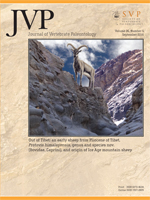The first nearly complete and articulated manus of the ground sloth Mylodon darwinii, from the upper Pleistocene of Argentina, is described. It shares similarities with Mylodonopsis ibseni from Brazil, including a cuneiform with a distinct pisiform facet, an obliquely concave ulnar facet, and a prominent distolateral process, as well as a gracile metacarpal III. It shares a flattened pisiform with Glossotherium robustum. The trapezoid is unique in the obliquely elongate proportions of its dorsal surface. Shapes of the articular facets indicate different functions in digits II and III, with the former having a greater range of motion and the latter greater stability at the joints. Clear arboreal or fossorial adaptations are absent. A phylogenetic analysis recovered M. darwinii as closely related to M. ibseni and agrees with larger phylogenetic analyses of sloths based on craniomandibular evidence. Our data support more than two mylodontine dispersal events to North America.
How to translate text using browser tools
1 September 2016
The Manus of Mylodon darwinii Owen (Tardigrada, Mylodontidae) and Its Phylogenetic Implications
José A. Haro,
Adan A. Tauber,
Jerónimo M. Krapovickas
ACCESS THE FULL ARTICLE





